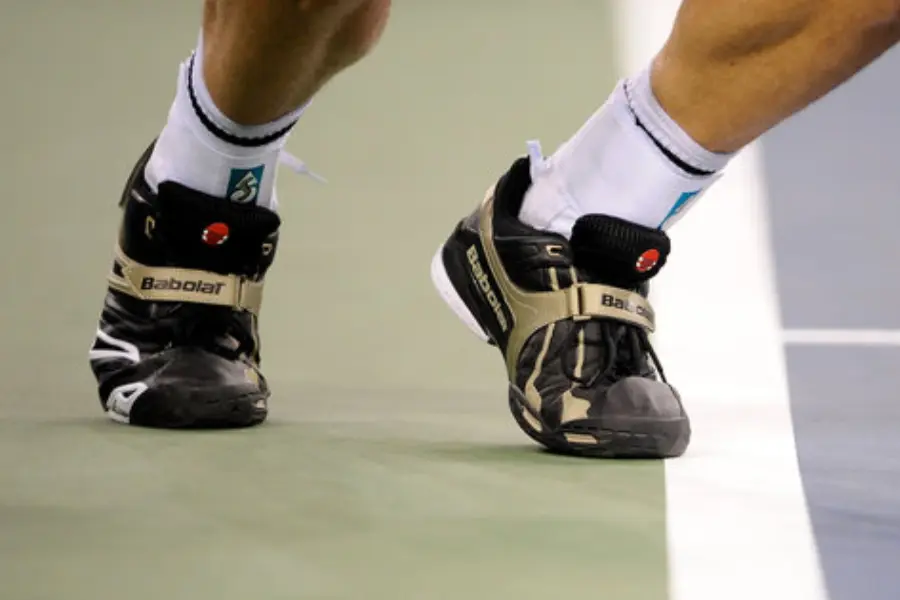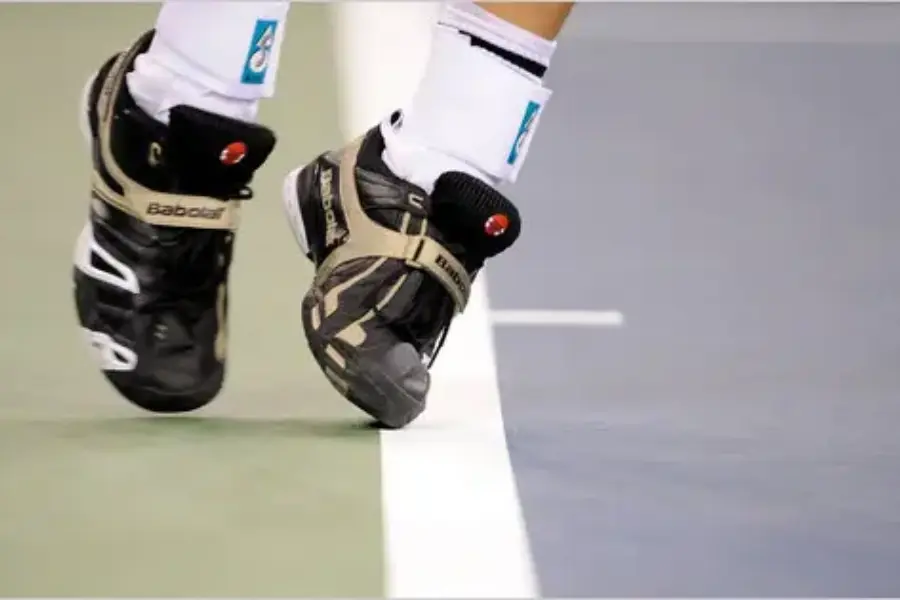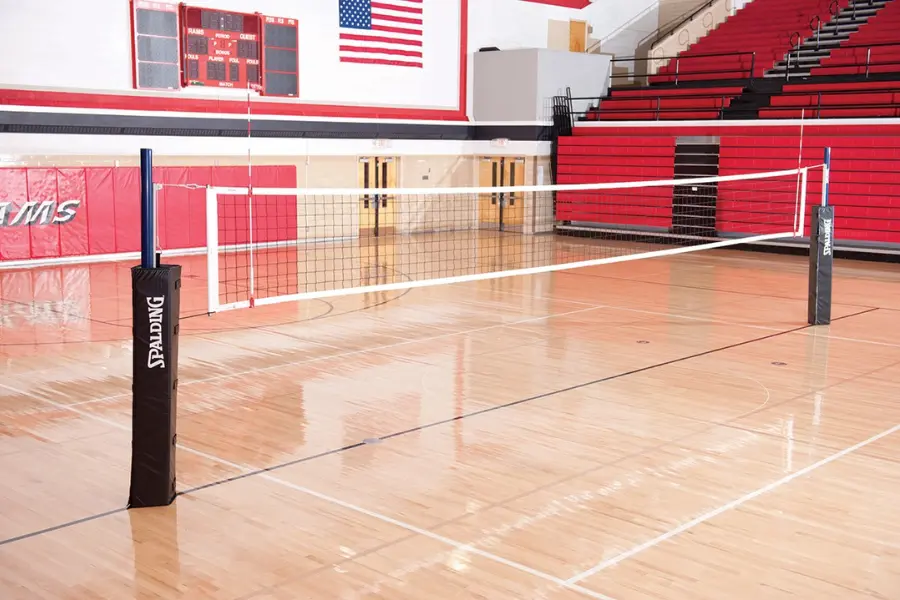It is possible to make a foot fault in volleyball during a service attempt or during normal play. As the designated ball-server makes a serve, they are considered to have committed a foot fault if they step out of the service zone or on the service line.
Foot faults can also be committed by players who cross their feet over the centerline and beneath the net into the opponents’ territory.
What Is A Foot Fault In Volleyball? Definition

A foot fault penalty can be applied to a player on either team whenever any part of their foot steps beyond a boundary line. A foot fault committed during a serve is the first type of foot fault. Whenever the volleyball player serves the ball to the opposing team, he or she must step back into the service zone, just behind the end line, because the player is located in the rear right side of the team’s territory.
When serving, the server must remain in the service zone and cannot touch or cross the end line, even if they step forward or jump to strike the ball over the net. Foot faults and fouls will be assessed to a server if their feet accidentally touch or cross the end line.
Foot faults over the centerline are another type of foot fault in volleyball. Front row players, those closest to the net, are typically responsible for this type of fault.
Foot faults are committed by players whose feet cross beneath the net during play. On occasion, however, a player may accidentally cross the line between the two territories of the court with their feet as they chase the ball or try to block it from being passed over the net.
What Is A Net Foul In Volleyball?
Volleyball players commit net fouls when they touch the net or get part of their body on the net before the ball is out. During a rally or while serving, this can happen. If a net foul occurs, the opposing team scores a point.
In order for the rally to be legal, the ball must pass over the net. Referees and players can both call net fouls in the game, and they are important components.
Volleyball Foot Fault
Taking too many steps while playing or touching the playing court outside the boundaries of his or her designated playing area is a volleyball foot fault. An opponent can earn a point for this illegal move.
A player must stay within the court boundaries and limit his or her movement in one direction to three steps in order to prevent a foot fault. In order to prevent these types of fouls, it is important to be familiar with the rules of the game and the court boundaries.
Volleyball Rule
During volleyball, two teams are divided by a net and play against each other. Each team passes a ball over the net until the other fails to return it. To ensure a safe and fair game, there are a few rules to follow.
You cannot hold, carry, or throw the ball without touching it with your hands or arms. In order to pass the ball over the net, it must be hit three times or less by each team before being passed over again. If the ball hits the ground without being caused to hit it, the team that did not cause it to hit it receives a point. A team wins the game if it reaches 25 points first.
Before serving the ball, a player cannot hit it with two hands, toss it in the air twice, dribble it, or move it around before standing behind the end line. As soon as the ball is placed in play, the serve must occur within eight seconds.
During five-player games, ghosts (non-existing players) will take over the starting position of the team. After the ghost moves into position one to serve, the opposite team receives a point, and they take possession of the ball.
Rules are in place in order to ensure a fair and safe game, as well as to make sure all players have a good time. A libero wears a different colored jersey as the defensive captain.
You may enjoy reading Volleyball Weight in Kg
What Are The Two Fouls In Volleyball?

To master volleyball, you must be agile, strong, and skilled. It is possible to commit two types of fouls in volleyball. In the first instance, a player touches the net with their body or other object, causing a net violation.
Secondly, a foot fault occurs when a player’s foot lands outside of the area they are supposed to be on. A foul in either of these situations can result in a point for the opponent, so it is crucial that players stay within the rules and are aware of their positioning.
It is important for players to be able to pass, set, and kill (or hit) well in volleyball because it is such a fast-paced sport. For a player to be successful in the game, understanding the different types of hits is essential. Each of these types of hits has a specific technique for how players hit the ball, whether it is a bump, a volley, or a spike.
A bump or a pass is technically a two-handed hit, but a volley is a single-handed strike. One hand is required to reach a spike, and one must jump off the ground to make the hit.
In addition, players must be aware of the rules prohibiting scooping, holding, lifting, or pushing the ball, as well as their ability to use an open hand underhanded motion. A player can become skilled and successful if they understand and follow these different types of hits.
Why Is Foot Allowed In Volleyball?
There is no restriction on using your feet when playing beach volleyball, regardless of whether you are a woman or a man. In both indoor and outdoor volleyball, you are allowed to use your feet. Contacting a volleyball with your feet was previously prohibited. It is no longer illegal to deal with this issue.
Volleyball involves kicking the ball with your feet. Any part of the body may be used to hit the ball, as long as it is only attempted once, according to the rules of the game. Consequently, you can make contact with the ball using your arms, legs, feet, or head. It is a good technique for volleyball players to use their feet to increase power and accuracy.
The soles of players’ shoes can also be wiped before the game to increase grip and friction, which will improve their passing and shooting accuracy. Players can score more points and dominate the court by using their feet.
A New Era In NCAA Volleyball Rules: Unlocking New Opportunities
Volleyball rules have changed significantly since NCAA volleyball was founded. As of 1999, any part of the body could touch the ball, including the foot. Because of this, players were able to pass and control the ball with their feet.
Three consecutive touches of the ball by a player are permitted, but two consecutive touches by the same player are not permitted. It is permissible for one player on the same team to hit the ball again if both players hit it in the same direction at the same time.
A three-run shot is allowed if each block is legal and not counted as a contact at the net. As time passes, these rules have evolved into a dynamic and exciting game.
Result
A foot fault penalty usually results in a single foul. A single foul automatically awards a point to the opposing team, along with a side out. When a side out occurs, the opposing team receives the ball and the opportunity to serve, since they have earned a point for the foul.
During a live ball, if two fouls are called simultaneously by opposing teams, a replay is called, and the rally continues without a point being awarded. The penalty occurs when both teams commit a double foul, including a foot fault, with the ball dead.
Referee Signal
In volleyball, line judges signal foot faults by holding flags outside the court and observing the movement of players and balls. Line judges will raise the flag in their hand if they spot a foot fault during service or play of the ball, wave it over their head while pointing to the net antenna or the line that contains the foot fault.
You may enjoy reading Hardest To Easiest Positions In Volleyball
Volleyball Foot Fault Under Net

An attack or serve that goes outside a player’s designated playing area is considered a foot fault in volleyball. When a player attempts to execute a shot, he or she often comes into contact with the court outside the boundary lines of the court due to a foot fault under the net.
Due to the difficulty of moving around the net, this can be a difficult violation to call. Keeping track of where one’s feet are at all times and observing the court boundaries are essential for players.
Volleyball Foot Fault Signal
Line judges will raise the flag over their heads and point at the net antenna or line where they detected the foot fault during service or play of the ball.
What Is The Hand Signal Of Foot Fault?
Distribute blame among the other team’s players. Signals can be divided into four types. What are they?
Call a foot fault before notifying the server
An athlete crosses the baseline before striking the ball. Thus, it is the sole responsibility of the receiver or the receiver’s partner to call a foot fault when a violation is observed, unless all other reasonable efforts have failed and the violation is so blatant as to be inconsequential. Referees, line judges, and umpires are also able to call foot faults on the court.
Court officials could therefore call a foot fault whenever they witnessed clear violations of court rules, including the receiver, his or her partner, and the receiver’s partner.
The server cannot be notified of a foot fault automatically, so reasonable efforts should be made to notify it. The palm of your right hand should be perpendicular to the floor.
You may enjoy reading Why Are Volleyball Shorts so Short
What Are The Signals In Volleyball?
The arm that you use to serve should be placed in the center of the team. Spread your fingers out by raising eight fingers. Your palms should be facing the opposite direction when you raise your arms vertically and forward.
Press the forefinger down to make a circular motion. When sitting in the 12th row, you should point your arm and fingers toward the floor. A fair and safe volleyball game requires some rules to be followed.
Analyzing chemical signaling in order to unlock its mysteries
It regulates local cell division within a cell and regulates cell division within a cell using short-range signaling. Endocrine signaling involves a cell releasing a chemical signal into the bloodstream, which circulates through the body and targets receptors on various cells (Figure 1B).
A systemic regulation mechanism, such as digestion regulation, uses this type of signaling.
As the name implies, autocrine signaling involves the release of chemical signals from one cell to another that bind to receptors on that same cell (Figure 1C).
In order for cells to grow and differentiate, this type of signaling is required. Intercellular channels are used to transmit direct signals across gap junctions in this example.
In many processes, such as cell communication, this type of signaling is expressed. In multicellular organisms, cell communication is important for coordination of activities and communication among cells.
In general, it can be categorized into four types: paracrine, endocrine, autocrine, and direct signal. Among the functions of paracrine and endocrine signaling are local and systemic regulation, autocrine signaling across gap junctions, and direct signaling across gap junctions.
All four chemical signaling pathways serve the same purpose in multicellular organisms for proper function and coordination of their activities. In order to indicate the direction of service, an official must use his hand signals indoors.
Several examples
Example 1: While preparing to serve, Player 1, from Team A, steps forward, but crosses the end line accidentally, leaving the service zone. Team B is awarded a point when the whistle blows, marking a foot fault.
Example 2: In an attempt to push the ball over the net, Player 1, from Team A, and Player 2, from Team B, either jump or block to try to push the ball over. They cross over the centerline and under the net in their attempts. Replays are conducted after the line judges call a double foul.
Example 3: Players 1 and 2 of Team A both step over the centerline after the ball is declared dead. Because the ball was dead at the time, the line judges call a foot fault, so both teams must rotate their players.
How To Call A Foot Fault In Volleyball
Volleyball requires quick and accurate foot fault calls. Before calling the fault, players must ensure their foot touched the line or crossed it. If a fault is called after the ball has been touched or hit, it will not count. The fault must be called while the ball is still in play. Be vocal and loud enough to be heard by everyone on the court when calling a foot fault. It is also important for the player to point out where the fault occurred. Foot faults should also be called clearly and specifically.
A foot fault can have severe consequences for the player who commits it in tennis. Players commit foot faults by failing to adhere to court rules such as serving limits or centerline restrictions. Penalties can be harsh for such offenses.
An opponent who commits a single foul (for example, a double hit or foot fault) is eliminated from the game. In cases of double fouls during a live ball play, a replay may be requested by the referee.
Foot faults are only called if an official is summoned by either the receiver or their partner as soon as possible after the foot fault occurs. The foot fault occurs when all efforts have been in vain and the error is so obvious that it can easily be seen from the receiver’s point of view. It is imperative that players follow the court rules and regulations strictly since any violation can result in harsh consequences.
You may enjoy reading Importance Of Utility Players
What Happens When A Foot Fault Is Called?

How does a foot fault affect the outcome? Foot faults shouldn’t be ignored; they simply mean the serve you just hit will be counted as a fault. The point is won if the first serve was a first serve; the point is lost if the second serve was a second serve.
Tennis Foot Faults: Avoiding Costly Mistakes
Foot faults are caused by a tennis player crossing the service area with their foot before hitting the ball. When serving, players should watch the boundaries of the service court to prevent errors that could result in a loss of a point. Besides knowing the rules and regulations of the game, tennis players should also know the rules and regulations of the game.
To ensure that the server serves from the proper area and that he does not take advantage of the service, the service court has set up service court boundary lines.
A player who commits a foot fault loses the point, and the other player wins. Tennis players must understand the rules and regulations of the game, as well as the boundaries of service courts, to succeed. A foot fault can cost a player points and affect their performance in the game. Playing tennis requires players to be aware of the rules and boundaries.
Why Would The Ref Call A Foot Fault While You Are Serving?
The player’s foot could be at fault for a foot fault if it touches anything adjacent to the baseline or the imaginary extension of the center mark when he places his foot. The server’s foot must touch any part of the baseline if a foot fault is called during the serving motion. Rule 18 of the official Game Rules has a rule about this.
Volleyball Rules: Don’t Cross The Line
Serving requires you to keep your foot from crossing the end line. As a result, the ball is side-out — or changed possession — as a result of the foot fault. As well as landing the ball on the net, the server should ensure the ball lands properly after serving.
If the ball touches the net during a goal, it is no longer a fault. Rule 19b also considers swinging and missing a serve a fault. A successful and enjoyable game requires familiarity with the rules. On the Officiating page, you can find more information.
What Is The Foot Rule In Volleyball?
In serving the ball, the player’s foot cannot touch the baseline before contact with the ball. The ball and point are awarded to the other team if the foot touches the line first.
Unleashing Volleyball’s Potential With The Foot Rule
With the NCAA’s 1999 amendment to its rules, volleyball players now have the option of hitting the ball with any part of their body. There is no longer a prohibition against players hitting the ball with their feet. Basically, it measures how far the ball is from the ground so that it will not be hit too far or too low. Using this one-foot ruler, you can measure how high the ball is when struck.
Whenever the ball goes too high or too far, a fault is called. As a result of the Foot Rule, volleyball players have been able to improve their skill and creativity on the court. Players now have a wide range of opportunities to hit the ball, since they can do so anywhere on their body. In addition to making golf more exciting, the Foot Rule allows players to use a variety of techniques to hit the ball.
As a result of the Foot Rule, volleyball players are able to move freely and play at an incredibly high level. Because of this, players have enjoyed and found the game more challenging and exciting. Sport has benefited from the Foot Rule and will continue to benefit from it.
You may enjoy reading Utility Position In Volleyball
FAQs
What is a foot fault in volleyball?
When a player’s feet cross a prohibited boundary in volleyball, it is called a foot fault. Foot faults in volleyball can be classified as either service foot faults or centerline foot faults. Players who serve the ball can serve foot faults by accidentally or intentionally touching the end line or crossing it with their foot. When one team’s player crosses their foot beneath the net and across the centerline into the other team’s territory, they are committing centerline foot faults.
Can Your Foot Go Under The Net In Volleyball?
Players do not need to touch the net or step over it, nor do they need to step over the center line (although their foot may land on it if it does not fully contact it). The ball can also be reached under the net, but it cannot be touched above the center line.
When a volleyball player is called for a foot fault, what are the consequences?
In volleyball, a foot fault is a type of foul. While the ball is live, a single foul is awarded to the opposing team if a server or player commits a foot fault. If the opposing team commits a foul, the ball is served to them. In the event of a double foul, both teams must commit fouls to end the rally, and no points are awarded. Double fouls during a dead ball result in both teams being penalized and rotating their players.
What Is An Under The Net Violation In Volleyball?
In volleyball, can you go under the net? In order to enter under the net, one must not step fully onto the court, but the net must not interfere with the player’s play.
Are you capable of stepping over the line when serving volleyball?
Servers are prohibited from serving the ball over the end line and out of the service zone according to traditional volleyball rules. Most volleyball forms consider this a foot fault and will penalize the other team with a point. Private games and volleyball leagues are, however, available. If the server does not completely leave the serving zone, they are permitted to step over the end line during a serve. However, some players may find it easier to play the game with these rules or they may suggest adaptations based on the measurements and space on the court.
Conclusion
Foot Foul In Volleyball must be understood and addressed if fair play is to be maintained. Foot fault rules promote a level playing field for both teams by ensuring that players move and serve within the designated boundaries.
It is the officials’ responsibility to enforce these rules and ensure that players abide by them.





